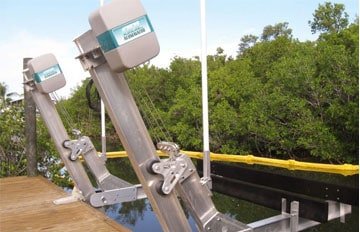If you have a boat lift, the cable is one of the most used components that require proper care and maintenance. When determining how often you should replace your lift cable, it will depend on a visual inspection. There are a few key points that you need to check. Be sure to lower the lifting platform when inspecting the cable and start with examining the cable’s vertical length.
Never inspect the cables without wearing leather gloves. Sliding your bare hands on the cable can cause injury. If you look closely, the cable is made of multiple wire strands and wraps. When there is excessive corrosion or fraying, the cable becomes prone to damage.
Cable wear you need to watch out for
As they say, nothing lasts forever. Even when you make it a point to maintain your cables properly. There will come a time when cable wear will occur. There are two types of cable wear that you need to be aware of: External cable abrasion: This type of abrasion will occur when the cable bends around while rubbing against the adjoining drum or cable. Internal cable abrasion: If the strands work against each other, it will cause internal cable abrasion, especially when under load. The lifespan of your lift cable will depend on the care and maintenance it receives, the type of cable you have and the number of times it’s used. The cable experiences wear every time you lower or raise the boat over the winch drum. The stand of wire moves at a varying speed. When abrasion occurs, some strands will become loose, which causes the cable to lose its strength.How to prevent premature wear
You need to apply penetrating oil as this will reduce the friction on the strands of wire. If you have galvanized cables, be sure to apply the oil occasionally. Lubrication ensures that the galvanized coating is preserved. You also reduce abrasion between the wire strands. Avoid using grease as it does not do a good job in lubricating the strands. It traps the moisture inside the wire stands instead. Be sure to use penetrating oil so you can get the best results. If your lift cable is made of stainless steel, you can also apply a few squirts of penetrating oil. Lubrication won’t solve the problem if your lift cable has excessive broken strands, deformities, kinks, and heavy corrosion. If you are not sure about the specifics of your boat lift cables, take a look at the owner’s manual for more information.Should you immediately replace cables that show signs of corrosion?
Corrosion is common in galvanized cables. As much as you want to preserve the strands, the galvanized coating may wear away if left without protection. When there is a sign of heavy rust, you can expect your lift cable to lose its strength. It should be replaced immediately as you could no longer restore it to its best condition. Even if your lift cable is well maintained, you still need to replace your cable every two years. Stainless cable, on the other hand, may last longer. You might not immediately notice that your cables have rust or internal abrasion. It only becomes visible when your cable starts to fail. If your boat is improperly positioned, it can cause the cable to fall apart dropping your boat. Replace your lift cable if you are starting to doubt its performance. A worn cable is not worth the risk.

